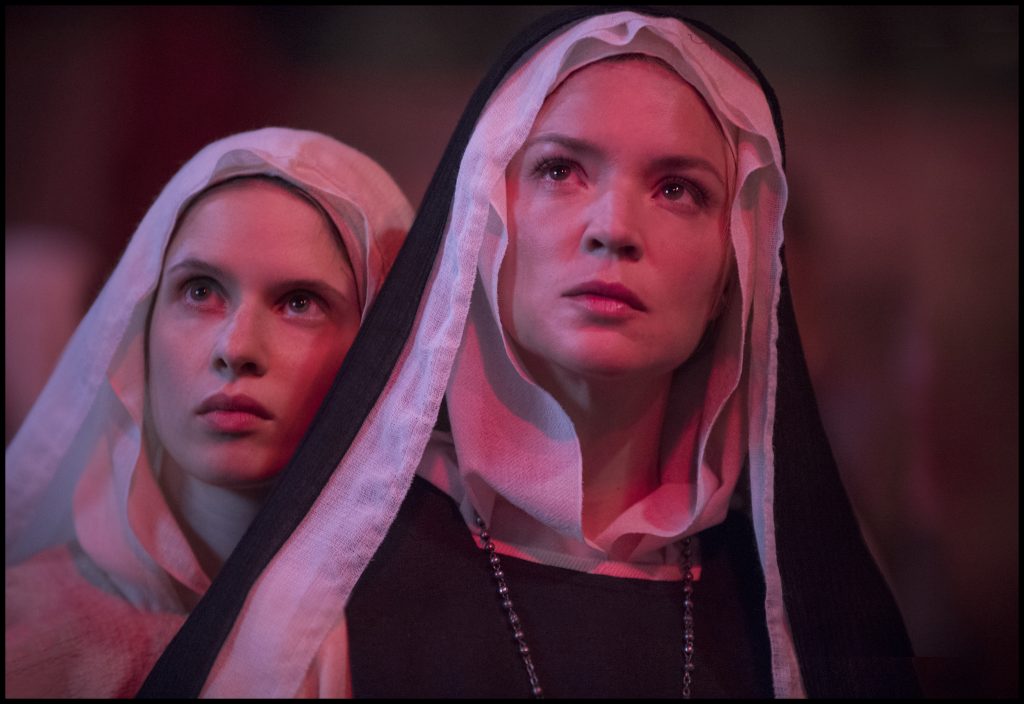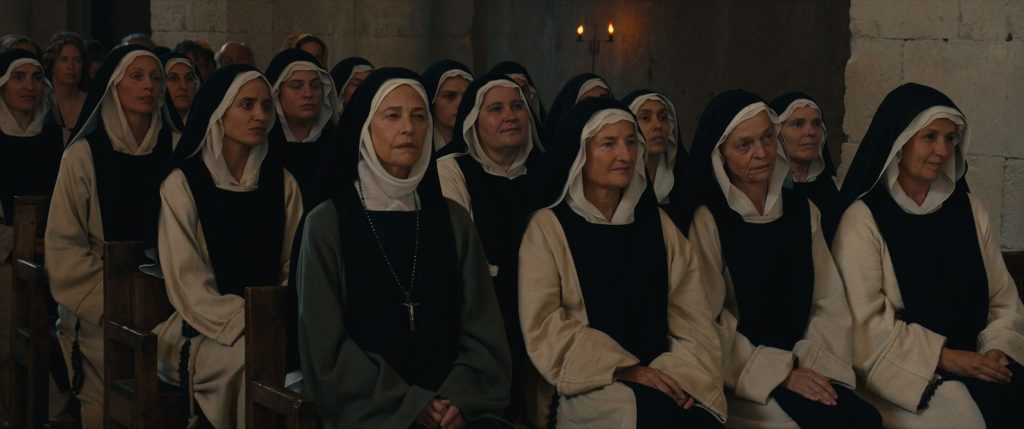Benedetta, Blessed Virgin, Cannes Film Festival, Charlotte Rampling, Clotilde Courau, Daphne Patakia, David Clavel, Elena Plonka, film festivals, Frederic Sauzay, Lambert Wilson, LGBTQ, Louise Chevillotte, movies, New York Film Festival, Olivier Rabourdin, Paul Verhoeven, reviews, Virginie Efira
February 5, 2022
by Carla Hay

Directed by Paul Verhoeven
Culture Representation: Taking place in 17th century Italy, the dramatic film “Benedetta” features an all-white cast of characters representing the working-class, middle-class and wealthy who are connected in some way to the Roman Catholic Church.
Culture Clash: A nun, who claims to have visions of Jesus Christ visiting her, gets involved in a taboo sexual relationship with another woman living in the convent.
Culture Audience: “Benedetta” will appeal mainly to people who are interested in movies that have provocative but ultimately not very groundbreaking depictions of how religion and sex are handled by the Catholic Church.

“Benedetta” is not as subversive as perhaps the filmmakers want it to be, because this dramatic depiction of a true story is often campy and predictable. The intrigue is in the cast members’ performances, which are never boring. In its observations about religious hypocrisy and misogyny, “Benedetta” also strives to have more meaning than just being known as a “lesbian nun” movie. “Benedetta” (which also has the title of “Blessed Virgin,” depending on where the movie is released) had its world premiere at the 2021 Cannes Film Festival and its North American premiere at the 2021 New York Film Festival.
Paul Verhoeven directed “Benedetta” and co-wrote the movie’s screenplay with David Birke. The movie, which takes place in 17th century Italy, is based on Judith C. Brown’s non-fiction book “Immodest Acts: The Life of a Lesbian Nun in Renaissance Italy.” That “lesbian nun” is Benedetta Carlini (played by Virginie Efira), who is eventually labeled as “insane” by church officials because of her adamant claims that Jesus Christ appears to her in visions. Benedetta also claims to have stigmata wounds, as proof that she communicates with Jesus. About the same time Benedetta has been branded as mentally ill, Benedetta is revealed to be having a sexual relationship with a nun-in-training who’s living in the same convent: Bartomolea (played by Daphne Patakia), who was the one who initiated the affair, according to how this movie depicts it.
“Benedetta” essentially leaves it open to interpretation if Benedetta would have been treated as harshly if there was no sexual activity in her scandal. Would she have been viewed as just a harmless oddball with an active imagination of communicating with Jesus Christ? The movie could also make people think about the implications of gender inequality: When a (male) Catholic priest is caught breaking the vows of celibacy, is the Catholic Church (and society in general) more likely to overlook it or be quicker to forgive a priest, compared to a (female) Catholic nun who does the same thing?
One point the movie definitely makes is that women can be just as misogynistic as men can be when it comes to judging other women. “Benedetta” predictably has a “battle-axe” villain nun named Sister Felicita, the Abbess (played by Charlotte Rampling), who is all too eager to get involved in the downfall of Benedetta, because Benedetta dared to question Sister Felicita’s authority. There are also obvious signs that Sister Felicita felt threatened that the younger and more physically attractive Benedetta would become more popular with the male clergy in charge of making decisions in the convent’s power structure.
Another antagonist to Benedetta is a nun named Sister Christina (played by Louise Chevillotte), who is the first person in the convent to find out about the secret affair between Bendetta and Bartomolea. And it happens around the time that Benedetta’s visions of Christ have made her a rising star at the convent. It all leads to a predictable showdown of back-and-forth accusations and female cattiness, presided over by an all-male group of Catholic Church officials who will decide who’s telling the truth and what will happen to Benedetta.
Two of the officials who will decide Benedetta’s fate are Alfonso Cecchi (played by Olivier Rabourdin) and the Nuncio (played by Lambert Wilson), who doesn’t have a first name in the movie. Alfonso, who has ambitions to become a bishop, is more inclined to believe Benedetta’s claims. The Nuncio, who acts as a government messenger/ambassador for the Pope, gives a lot of weight to the opinions of Sister Felicita, who wants to be his political ally. Even though the Nuncio has taken the vow of celibacy, there are hints that he has violated of that vow, such as having sex with prostitutes and getting his maid pregnant.
“Benedetta” takes perhaps a little too much time in the beginning of the movie to over-explain Benedetta’s restrictive childhood. The movie shows that Benedetta was a very devout Catholic who adhered to the tenets of the Catholic religion, but she was already claiming to have special communication with deities. One of the more interesting aspects of “Benedetta” is how it keeps viewers guessing over whether or not Benedetta was really a non-conformist “psychic,” a mentally ill eccentric, or a very skilled con artist.
At 12 or 13 years old, Benedetta (played by Elena Plonka) travels with her father Giuliano (played by David Clavel) and her mother Midea (played by Clotilde Courau) to the city of Pescia so that she can get her confirmation veil. On the way there, the family is stopped by some soldiers, who steal a necklace from the family. Benedetta scolds the soldiers that they will be punished by the Virgin Mary for this theft. And just like that, bird excrement lands on the face of the soldier who has the necklace, and he gives it back. It’s one of many campy moments in the movie.
Viewers soon find out that Benedetta’s parents have essentially sold her to a convent. Because a nun is considered a non-sexual “bride” of Jesus Christ, Giuliano wants to be a hardball negotiator with Sister Felicita for how much of a “dowry” he can get from the Catholic Church. Giuliano asks Sister Felicita: “Is the bride of Christ worth less than 100 [in currency]?”
Another campy moment arrives when an adolescent Benedetta (who is now living at the convent) begins praying to a statue of the Virgin Mary, which is wearing a veil that extends down to the Virgin Mary’s chest. Suddenly, the statue falls on Benedetta, and the statue’s veil comes off to expose the Virgin Mary’s naked breasts. Benedetta than starts sucking on the breasts. This movie is not subtle at all in telegraphing what will happen later in the story.
The movie then fast-forwards 18 years later. Benedetta is now a headstrong nun who often clashes with Sister Felicita. One day, a woman in her early 20s bursts into the convent because she is being chased by her abusive father (played by Frédéric Sauzay), who calls her a “harlot.” The frightened woman is Bartomolea, who will eventually become Benedetta’s lover.
Bartomolea begs to be taken into the convent, but an unsympathetic Sister Felicita says that Bartomolea can only stay if her father pays a dowry. Her father (who doesn’t have a name in the movie) reluctantly obliges. Bartomelea than begins to live in the convent as a novitiate. Bartomolea and Benedetta share the same bedroom space, where their beds are separated by a thin curtain.
At first, Benedetta treats the younger Bartomolea as somewhat of a friend/protégée. Bartomolea confides in Bendetta, by telling her that after Bartomolea’s mother died in an unnamed plague, Bartomolea’s father made Bartomolea become his “wife.” In other words, Bartomolea was the victim of incest rape. Having a domineering and controlling father who abandoned them in a convent is something that both Bartomolea and Benedetta have in common, so it seems to strengthen their bond that the two women start to develop with each other.
Bartomolea has not taken the vows of celibacy as a nun, so she’s not as invested as Benedetta is in abstaining from sex. Bartomolea also isn’t as timid as she first seemed when she arrived at the convent. It isn’t long before Bartomolea makes it known to Benedetta that she’s sexually attracted to Benedetta. Benedetta thinks it’s sinful for a nun to act on any sexual urges, so she resists Bartomolea’s sexual advances. Benedetta also tells Bartomolea that she has visions of Jesus Christ saying that it’s a mortal sin to break her vows.
Over time though, Benedetta’s visions change. In Benedetta’s new visions, Jesus Christ begins to tell her that the previous Jesus that Benedetta was seeing is a false prophet. And soon afterward, Benedetta and Bartomolea are having secret sexual trysts in their bedroom. One of the more talked-about aspects of “Benedetta” is how a figurine of the Virgin Mary is used as a sex toy. The movie’s sex scenes leave no mystery about what goes on in these sexual encounters.
Regardless of how audiences might react to the movie’s explicit sexual content, one of the best things about “Benedetta” is that it shows how sex and religion are both used as ways to have power and control over people. Efira’s opaque performance as the rebellious Benedetta and Charlotte Rampling’s assured performance as the imperious Sister Felicita are fascinating to watch for these reasons. For all the attention that this movie is getting about the sex scenes, it’s worth noting that no matter what happens between Benedetta and Bartolomea, the power struggle between Benedetta and Sister Felicita will have a more lasting impact on all of their lives.
Benedetta’s visions of Jesus Christ aren’t all sweetness and light. She has a recurring nightmare that she’s being hunted down by men who try to rape her, and Jesus comes to her rescue. Of course, anyone can interpret these scenes as the would-be rapists being symbolic of patriarchy trying to take power away from Benedetta and any woman. At first, Benedetta sees the Catholic Church as her savior (with Jesus coming to her rescue in these visions), but eventually she’s conflicted and disillusioned over how much she should believe in the Catholic Church.
These attempted rape scenes are part of a pattern of filmmaker Verhoeven’s fixation on showing the rape or attempted rape of women in almost all of his movies. He’s gotten a lot of criticism over the years for his very “male gaze” films, where women’s naked bodies are used for explicit, full-frontal sex scenes and/or violence, but the men in Verhoeven’s movies almost never have full-frontal nudity. It’s a double standard that Verhoeven doesn’t seem interested in acknowledging or ending in his movies.
As much as Verhoeven points out in “Benedetta” how the patriarchy of the Catholic Church is responsible for a lot of sexual hypocrisy that shames women and absolves men, Verhoeven has made an entire career of doing films about some type of female exploitation. If not for the quality of talent that Verhoeven works with in casts and crews, many of Verhoeven’s so-called “artsy” movies would be B-movie schlock. That’s why “Benedetta,” although it has very good acting, is by no means a cinematic masterpiece.
IFC Films released “Benedetta” in select U.S. cinemas on December 3, 2021. The movie was released on digital and VOD on December 21, 2021.
